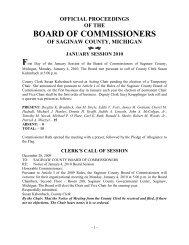Chapter 5 Urban Area Travel Demand Model - Saginaw County
Chapter 5 Urban Area Travel Demand Model - Saginaw County
Chapter 5 Urban Area Travel Demand Model - Saginaw County
Create successful ePaper yourself
Turn your PDF publications into a flip-book with our unique Google optimized e-Paper software.
1. Data Collection, in which socio-economic and facility inventory data are<br />
collected.<br />
2. Trip Generation, which calculates the number of person trips produced in or<br />
attracted to a traffic analysis zone (TAZ).<br />
3. Trip Distribution, which takes the person trips produced in a TAZ and<br />
distributes them to all other TAZs, based on attractiveness of the zone.<br />
4. Mode Choice, which assigns person trips to a mode of travel such as drive<br />
alone, shared ride 2, shared ride 3+, walk to transit, park and ride transit.<br />
5. Assignment, which determines what routes are utilized for trips. There is a<br />
highway assignment and a transit assignment.<br />
6. <strong>Model</strong> Calibration/Validation, which is performed at the end of each<br />
modeling step to make sure that the results from that step are within<br />
reasonable ranges. The final assignment validation involves verifying that<br />
the volumes (trips) estimated in the base year traffic assignment replicate<br />
observed traffic counts.<br />
7. System Analysis, tests alternatives and analyzes changes in order to<br />
improve the transportation system.<br />
There are two basic systems of data organization in the travel demand<br />
forecasting process. The first system of data is organized based on the street<br />
system. Roads with a national functional class (NFC) designation of "minor<br />
collector" and higher are included in the network. Some local roads are included<br />
to provide connectivity in the network or because they were deemed regionally<br />
significant. The unit of analysis is called a "link." Usually, a link is a segment of<br />
roadway which is terminated at each end by an intersection. In a traffic<br />
assignment network, intersections are called "nodes." Therefore, a link has a<br />
node at each end.<br />
The second data organization mechanism is the Traffic Analysis Zones (TAZ).<br />
TAZs are determined based upon several criteria, including similarity of land<br />
use, compatibility with jurisdictional boundaries, the presence of physical<br />
boundaries, and compatibility with the street system. Streets are generally<br />
utilized as zone boundary edges. All socio-economic and trip generation<br />
information for both the base year and future year are summarized by TAZ. The<br />
Traffic Analysis Zones used for model development are depicted on a series of<br />
maps that are on file with the MPO and available for viewing at the SMATS<br />
office. They have not been reproduced here due to space limitations.<br />
SMATS 2040 MTP 5-2



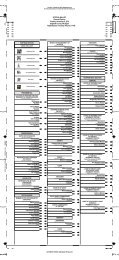
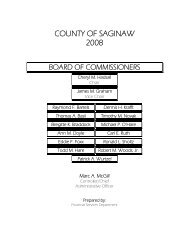

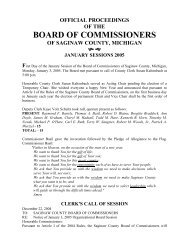
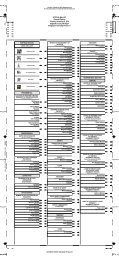

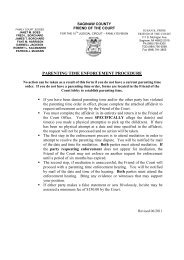
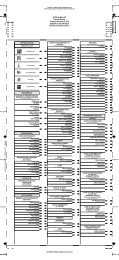

![[ Of Commissioners] - Saginaw County](https://img.yumpu.com/25951211/1/190x245/-of-commissioners-saginaw-county.jpg?quality=85)


